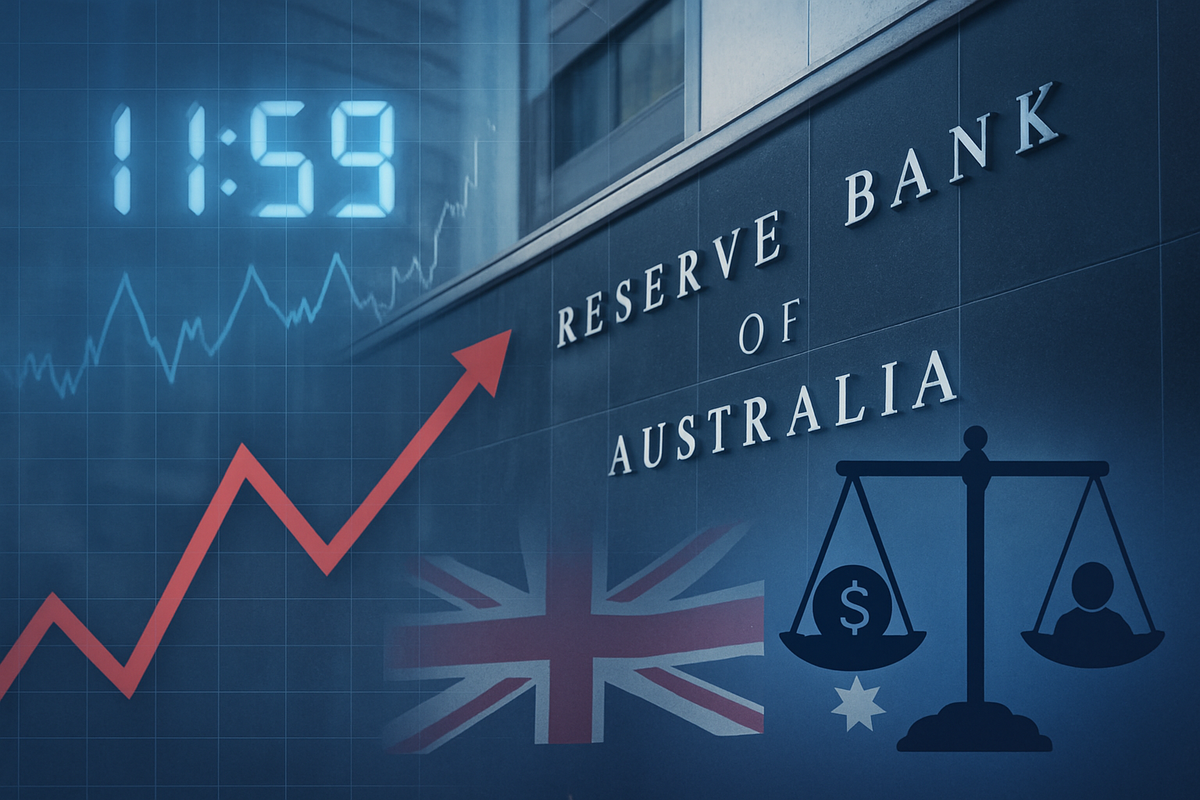
Sydney, Australia – Financial markets across Australia are bracing for the highly anticipated release of the third-quarter 2025 Consumer Price Index (CPI) data, due on Wednesday, October 29, at 11:30 am AEDT. This critical inflation report is set to be a pivotal moment for the Reserve Bank of Australia's (RBA) monetary policy, with analysts and investors closely scrutinizing the figures for clues on the central bank's next move. However, recent hawkish commentary from RBA Governor Michele Bullock has significantly raised the hurdle for any immediate interest rate cuts, suggesting that even a modest inflation reading might not be enough to sway the RBA from its vigilant stance against persistent price pressures.
CPI Data Takes Center Stage Amidst RBA's Unwavering Focus on Inflation
The upcoming Q3 2025 CPI release is widely expected to show a notable acceleration in inflation. Market consensus forecasts anticipate a quarterly headline CPI increase of 1.0% to 1.1% quarter-on-quarter (QoQ), which would push the annual headline inflation rate to 3.0%, a significant jump from 2.1% in Q2 2025. Crucially, the RBA's preferred measure, the trimmed mean CPI, is projected to rise by 0.8% QoQ, with the annual rate expected to hold steady at 2.7%. Some economists even foresee the trimmed-mean inflation reaching as high as 0.9% QoQ, a figure RBA Governor Michele Bullock has reportedly flagged as a "miss," approximately 30 basis points above the RBA's own forecast.
This impending data arrives after a period of calibrated RBA policy adjustments. The central bank had initiated its first interest rate cut in over four years in February 2025, bringing the cash rate down, followed by further reductions in May and August 2025, settling at the current 3.60%. However, these cuts were swiftly accompanied by cautious rhetoric from Governor Bullock, who emphasized that these moves were not a precursor to a rapid easing cycle. She explicitly stated that "further decisions on interest rates will depend on inflation data continuing to show a consistent downward trend" and dismissed market expectations for multiple further cuts in 2025 as "overly optimistic."
The RBA's unwavering focus remains on ensuring inflation sustainably returns to its 2-3% target band. Despite a recent uptick in the unemployment rate to 4.5% in September 2025 – its highest since late 2021 – Governor Bullock has downplayed fears of a significant economic downturn, noting that job creation continues, albeit at a slower pace. This suggests the RBA is willing to tolerate some softening in the labour market if it means achieving its inflation mandate. Market expectations for a November rate cut, which were as high as 74% earlier in October, have sharply declined to around 15% following the Governor's recent remarks, underscoring the shift in sentiment and the perceived higher hurdle for any RBA easing.
Sectoral Impacts: Who Wins and Who Loses from Elevated Rates
The prospect of sustained higher interest rates, driven by persistent inflation and a hawkish RBA, will inevitably create winners and losers across various sectors of the Australian economy. Financial institutions, particularly the major banks, stand to benefit from a higher-for-longer cash rate environment. Lenders such as Commonwealth Bank of Australia (ASX: CBA), National Australia Bank (ASX: NAB), Westpac Banking Corporation (ASX: WBC), and Australia and New Zealand Banking Group (ASX: ANZ) typically see an expansion in their net interest margins (NIMs) when interest rates are elevated, as they can charge more for loans while the cost of deposits may not rise proportionally. However, this benefit could be partially offset by an increase in bad debts if higher borrowing costs lead to financial stress among households and businesses.
Conversely, sectors heavily reliant on consumer discretionary spending and debt are likely to face headwinds. Retailers like Woolworths Group (ASX: WOW) and Wesfarmers (ASX: WES), which owns Kmart and Bunnings, could experience reduced sales volumes as consumers grapple with higher mortgage repayments and living costs, leading to a tightening of household budgets. The real estate sector, including property developers and real estate investment trusts (REITs) like Goodman Group (ASX: GMG), could see a slowdown in activity, as higher interest rates translate to increased borrowing costs for developers and reduced affordability for homebuyers, potentially softening property values and development pipelines. Companies with significant debt loads or those planning large capital expenditures funded by borrowing will also find their financing costs elevated, impacting profitability and growth prospects.
Broader Implications: A Global Tightening Trend and Domestic Challenges
The RBA's cautious stance and the significance of the upcoming CPI data are not isolated events but reflect broader global economic trends where inflation has proven stickier than anticipated. Central banks worldwide, from the U.S. Federal Reserve to the European Central Bank, have been grappling with similar challenges, often adopting a "higher for longer" interest rate mantra. Australia's situation aligns with this global narrative, where strong labour markets and persistent supply-side pressures continue to fuel price increases. This alignment means that any RBA decision will be viewed in the context of global monetary policy, potentially influencing foreign exchange rates and capital flows. A more hawkish RBA, while supportive of the Australian Dollar, could also attract capital, but conversely, if the RBA is perceived as lagging behind global peers in tackling inflation, it could lead to currency depreciation.
Domestically, the continued fight against inflation carries significant ripple effects. Elevated interest rates and persistent inflation erode consumer confidence, potentially leading to a further slowdown in economic activity beyond what the RBA might desire. Businesses face increased operational costs and reduced demand, which could stifle investment and hiring. Historically, periods of sustained high inflation have often necessitated aggressive monetary policy interventions, sometimes leading to economic contractions. The RBA is attempting a delicate balancing act, aiming to bring inflation under control without triggering a severe recession. The current scenario draws parallels to previous cycles where inflation proved challenging to tame, highlighting the importance of clear communication and data-dependent policy from the central bank to manage market expectations and maintain economic stability.
What Comes Next: A November Hold, and Beyond
In the immediate aftermath of the Q3 2025 CPI release, all eyes will turn to the RBA's next monetary policy meeting in November. Given the prevailing sentiment and Governor Bullock's recent statements, a "hold" decision, keeping the cash rate at 3.60%, appears to be the most probable short-term outcome, especially if the inflation figures align with or exceed current forecasts. A stronger-than-expected inflation print, particularly in the trimmed mean, would solidify this stance and reinforce the RBA's commitment to its inflation target, potentially pushing out any prospects of rate cuts well into 2026. Conversely, a significantly weaker-than-expected inflation reading, while less likely, might re-ignite discussions around future easing, though the hurdle for such a move remains exceptionally high.
Looking further ahead, the trajectory of Australian inflation will dictate the RBA's long-term policy path. If inflation proves more entrenched, the RBA might even face renewed pressure to consider further rate hikes as a "nuclear option" to bring prices under control, a scenario Governor Bullock has implicitly warned against dismissing. For businesses and investors, this environment necessitates strategic adaptation. Companies will need to focus on cost efficiencies, pricing power, and resilient supply chains to navigate persistent inflation. Investors should prepare for continued volatility and prioritize investments in sectors that demonstrate strong pricing power or are less sensitive to interest rate fluctuations. Potential market opportunities may emerge in defensive stocks or those with strong balance sheets capable of weathering higher borrowing costs.
Wrap-Up: A Pivotal Moment for Australia's Economic Outlook
The upcoming Q3 2025 CPI data represents a pivotal moment for Australia's economic outlook, with significant implications for the Reserve Bank of Australia's monetary policy and the broader financial landscape. The central bank's firm commitment to combating inflation, even at the cost of some economic growth, underscores the seriousness with which it views persistent price pressures. The increased hurdle for interest rate cuts means that the RBA is likely to maintain a watchful and cautious stance, prioritizing its inflation mandate above all else.
Moving forward, investors should closely monitor not only the headline and trimmed mean CPI figures but also the RBA's accompanying statements and any shifts in its forward guidance. Key indicators to watch include wage growth, housing inflation, and global commodity prices, all of which will play a role in shaping Australia's inflation trajectory. The current environment demands a strategic and patient approach from market participants, as the RBA navigates the complex path towards sustainable price stability. The lasting impact of this period will be defined by the RBA's ability to successfully anchor inflation expectations and guide the economy to a soft landing amidst global economic uncertainties.
This content is intended for informational purposes only and is not financial advice





